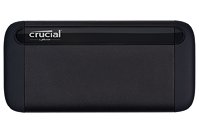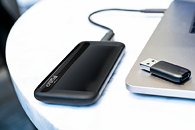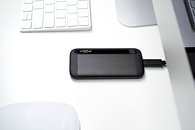Friday, October 25th 2019

Crucial Unveils the X8 Portable SSD
Micron's consumer storage solutions arm Crucial unveiled the X8 Portable SSD. The Crucial X8 is a lightweight, portable flash-based storage device that comes in capacities of 500 GB and 1 TB, and offers sequential transfer speeds of up to 1,050 MB/s reads. It leverages USB 3.1 gen 2 (10 Gbps) and UASP, and supports USB type-C. A type-C to type-A adapter is included in the package, but runs the drive at 5 Gbps. The drive requires USB 3.1 and isn't compatible with USB 2.0/1.1. This is because it needs 1.5 A of current, which older generation USB ports typically can't provide. A single cable with USB-C connectors on both ends handles both power and host connectivity.
Under the hood, the X8 is essentially a Crucial P1 M.2 NVMe SSD wired to an ASMedia-made USB-to-PCIe bridge chip. The X8 supports TRIM command if the volume is formatted in NTFS. Out of the box, it comes in a camera-friendly exFAT format with GPT. The drive is hence compatible with PCs (Windows 7 or later and GPT-aware *nix), Macs, the iPad Pro, Chromebooks, and Android devices that have USB 3.1. Although not certified, The Crucial X8 also works with Xbox One and PlayStation 4, and Crucial provides support on how to get the drive to work with these consoles, making it a formidable portable game drive given its sequential read speed. The drive is roughly the size of a 4-inch smartphone, and can survive drops onto carpet up to a height of 7.5 feet (2.28 m). It's not water-resistant. Backed by a 3-year warranty, the 1 TB variant (CT1000X8SSD9) is priced at $164.95, and the 500 GB variant (CT500X8SSD9) at $119.95.
Under the hood, the X8 is essentially a Crucial P1 M.2 NVMe SSD wired to an ASMedia-made USB-to-PCIe bridge chip. The X8 supports TRIM command if the volume is formatted in NTFS. Out of the box, it comes in a camera-friendly exFAT format with GPT. The drive is hence compatible with PCs (Windows 7 or later and GPT-aware *nix), Macs, the iPad Pro, Chromebooks, and Android devices that have USB 3.1. Although not certified, The Crucial X8 also works with Xbox One and PlayStation 4, and Crucial provides support on how to get the drive to work with these consoles, making it a formidable portable game drive given its sequential read speed. The drive is roughly the size of a 4-inch smartphone, and can survive drops onto carpet up to a height of 7.5 feet (2.28 m). It's not water-resistant. Backed by a 3-year warranty, the 1 TB variant (CT1000X8SSD9) is priced at $164.95, and the 500 GB variant (CT500X8SSD9) at $119.95.



9 Comments on Crucial Unveils the X8 Portable SSD
Buy external QLC you're ready to be careless and gamble with some of your data.
Since then they put the brakes on and put the whole process in reverse. Now NAND Flash memory is made using much larger process nodes to not only store more electrons by also increase the spacing between cells.
Micron is getting ready to move to 128 dies stacked.
www.anandtech.com/show/14942/micron-128layer-3d-nand-with-replacement-gate-cmos-under-array-taped-out
en.wikipedia.org/wiki/Charge_trap_flash